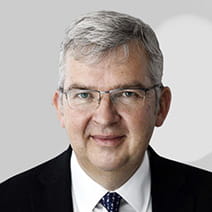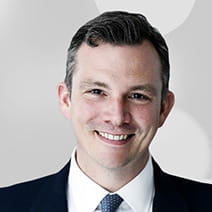Over the past few years, cyclical forces have had acute influence on markets. The world has become consumed by cyclical trends and discussion has focused on the impact of these cyclical forces on the outlook for both economies and investment markets.
We counter that these cyclical trends are now returning to more normalised long-term levels and it is structural growth trends that should be driving portfolio construction for the future.
Let’s start with the cyclical pressures that should inform tactical asset allocation over the short to medium term. In our view, cyclical pressures that spiked inflation over the last two or three years, caused by a global pandemic and the war in Ukraine, are broadly over. We are in a period where interest rates have normalised. If you look back over history, the median base rate in the UK has been around 5%, which is roughly where we are today. Without causing a deep recession and increasing unemployment, central banks around the world have brought down headline inflation.
They have achieved this because variables in the market have improved. These include global supply chains opening up while energy and food prices have come back down after the impact of Covid and the start of the war in Ukraine.
You can ask why central banks are not reducing interest rates given that headline inflation is moving down towards the magical figure of 2%. In our view, central banks are not cutting interest rates today because they are now more concerned with secular forces that we believe will keep inflation above 2%, maybe even 3 or 4%, for at least the next decade. And what are these forces? Deglobalisation, even though it is far from our favourite word, mitigating climate change, ageing populations and innovation.
Globalisation, limited geopolitical risk and the growth of trading around the world led to a fall in costs and the West enjoying a better style of living on the basis of production, which moved further and further to the east. We enjoyed decades of disinflation, falling rates, and central banks acting and behaving together almost in a queue behind the US Federal Reserve. We've seen quantitative easing, financial assets do well, and a rise in offshoring and just in time manufacturing. But now things are changing.
The transition to a fragmentation in globalisation and the secular trends that go with it have been happening during a slow transition. But happening they are in what I call a long goodbye.
Geopolitical risk has been rising over the past few years, certainly since Donald Trump became US President, and global trade started moving sideways during the Global Financial Crisis (GFC). This means we saw globalisation starting to break down 15 years ago. We have seen periods of globalisation followed by deglobalisation during the course of history; so what can we expect? To answer this, here are some more words beginning in D; disengagement, division and diversification.
Disengagement is all about the US, which has obviously been the leader in terms of the global economy, disengaging from the rest of the world. The US can do this because it has energy independence and food security.
Division is like being at school picking two teams: the US and China. Whose side do countries want to be on? Who do they want to trade with going forward? And diversification is a blend of the first two, it is making sure that you have more than one supply chain. If a country is just dealing with China, perhaps it might want to do a deal with India and Mexico going forward. And because of this, we're beginning to see fragmentation in economies and among the central banks.
Post the GFC, we have seen greater differentiation in the speed of economic growth between countries, with the US, for example, benefiting from being a leader in innovation. Just one example of the power of innovation is shown in the fact that when ChatGPT was introduced, it had 100 million members within two months. The US has also benefited from demographics in terms of having a younger population than the rest of the developed world. An even greater benefit for the US has been flexibility in their workforce and the ability for people to move states for work.
The fragmentation in globalisation means we should expect central banks to have their own national agenda going forward and not raise and reduce interest rates in sync.
And what about offshoring? It has been replaced by on-shoring or near-shoring. This means supply chains will come closer to home. This has implications for climate change and inflation. Instead of seeing a resource abundance, we're going to see more scarcity as people protect what they've got. Countries are not willing to share as much as they were in the past. Instead of adding to global warming, we're now beginning to fight global warming. There's a cost for this, particularly in a world where the cost of capital now is no longer zero, which is more like 4% to 5% going forward.
What does this all mean for portfolios? It brings us back to a strong case for diversification. 2022 wasn't a great year for diversification. And a basket full of US equities, especially large and mega caps, would probably have been the best way to invest over the last decade or so. We have seen very narrow leadership in recent years, developed markets outperforming emerging markets, and the rise of technology, passive investing and concentrated indices.
But one of the strongest forces in investing is reversion to the mean. The previous outperformance of the US coincided with the TMT bubble and the subsequent underperformance in the early noughties occurred when emerging markets and commodities did well. The US certainly has its strengths at the moment, but you have to pay for it. If you want something cheaper, then you can invest in Europe at half the price. You can invest in the UK at almost a third of the price. There are cheap valuations to be had in emerging markets, Asia and Japan.
The challenge is that there are so many investment opportunities with attractive valuations at the moment. The problem is more about where you decide not to invest rather than where you can invest.
The concentration of markets is important for active managers. If you're an active manager, the first thing you have to do is ask yourself how much money do you want to have in the top 10 stocks because they currently represent 31% of the S&P500 index in the US, for example. If you're an active manager, you've got to be doing something different but it is a very big call not to have a market weighting of what is the Magnificent Seven. Once we start to see some of the concentration reduced and a broadening of the market leadership, then in a period like we saw in the early noughties onwards, active managers are likely to be rewarded in terms of their stock picking.
We believe the biggest opportunity today though might not be in equities, but rather in income. When you're thinking about investing in income, the starting yield is all important and this opportunity just literally became a lot stronger overnight. And the increased level of income means investors in a balanced portfolio can reduce the risk they take to generate the same return from equities.
In conclusion, the opportunities from the secular trends we have highlighted are to focus on diversification, value investing, emerging markets, active management, bonds and the energy transition.
KEY RISKS
Past performance is not a guide to future performance. The value of an investment and the income generated from it can fall as well as rise and is not guaranteed. You may get back less than you originally invested.
The issue of units/shares in Liontrust Funds may be subject to an initial charge, which will have an impact on the realisable value of the investment, particularly in the short term. Investments should always be considered as long term.
The Funds and Model Portfolios managed by the Multi-Asset Team may be exposed to the following risks:
Credit Risk: There is a risk that an investment will fail to make required payments and this may reduce the income paid to the fund, or its capital value. The creditworthiness of a bond issuer may also affect that bond's value. Bonds that produce a higher level of income usually also carry greater risk as such bond issuers may have difficulty in paying their debts. The value of a bond would be significantly affected if the issuer either refused to pay or was unable to pay; Counterparty Risk: The insolvency of any institutions providing services such as safekeeping of assets or acting as counterparty to derivatives or other instruments, may expose the Fund to financial loss; Liquidity Risk: If underlying funds suspend or defer the payment of redemption proceeds, the Fund's ability to meet redemption requests may also be affected; Interest Rate Risk: Fluctuations in interest rates may affect the value of the Fund and your investment. Bonds are affected by changes in interest rates and their value and the income they generate can rise or fall as a result; Derivatives Risk: Some of the underlying funds may invest in derivatives, which can, in some circumstances, create wider fluctuations in their prices over time; Emerging Markets: The Fund may invest in less economically developed markets (emerging markets) which can involve greater risks than well developed economies; Currency Risk: The Fund invests in overseas markets and the value of the Fund may fall or rise as a result of changes in exchange rates. Index Tracking Risk: The performance of any passive funds used may not exactly track that of their Indices. Any performance shown in respect of the Model Portfolios are periodically restructured and/or rebalanced. Actual returns may vary from the model returns.
The risks detailed above are reflective of the full range of Funds managed by the Multi-Asset Team and not all of the risks listed are applicable to each individual Fund. For the risks associated with an individual Fund, please refer to its Key Investor Information Document (KIID)/PRIIP KID.
DISCLAIMER
This is a marketing communication. Before making an investment, you should read the relevant Prospectus and the Key Investor Information Document (KIID), which provide full product details including investment charges and risks. These documents can be obtained, free of charge, from www.liontrust.co.uk or direct from Liontrust. Always research your own investments. If you are not a professional investor please consult a regulated financial adviser regarding the suitability of such an investment for you and your personal circumstances.
This should not be construed as advice for investment in any product or security mentioned, an offer to buy or sell units/shares of Funds mentioned, or a solicitation to purchase securities in any company or investment product. Examples of stocks are provided for general information only to demonstrate our investment philosophy. The investment being promoted is for units in a fund, not directly in the underlying assets. It contains information and analysis that is believed to be accurate at the time of publication, but is subject to change without notice. Whilst care has been taken in compiling the content of this document, no representation or warranty, express or implied, is made by Liontrust as to its accuracy or completeness, including for external sources (which may have been used) which have not been verified.











